The 3-hydroxyphenyl phosphinyl propanoic acid market is projected to grow from USD 47.69 million in 2025 to USD 71.97 million by 2035, reflecting a CAGR of 4.2%. A decade-long comparison of growth periods highlights both stabilization and acceleration phases, showing how incremental improvements in synthesis and rising end-use diversification collectively shape expansion.
Between 2025 and 2030, the 3-hydroxyphenyl phosphinyl propanoic acid market is anticipated to record moderate growth. This phase will be largely characterized by advancements in pharmaceutical synthesis, as the compound plays a role in producing targeted molecules and intermediates used in research and clinical development. Specialty chemical applications also provide traction, particularly where phosphinyl derivatives support functional group transformations in fine chemical synthesis. Growth during this period is expected to be driven less by large-scale demand and more by steady adoption across laboratories, small-scale production lines, and niche industrial users. A major focus will rest on establishing production consistency, improving purity levels, and optimizing synthesis methods to meet the increasingly strict quality standards required by pharmaceutical and specialty chemical manufacturers. Companies engaged in this period will concentrate on refining processes to reduce waste, improve yields, and align with regulatory guidelines, laying the foundation for broader adoption in later years.
From 2030 to 2035, the growth curve is projected to strengthen as scalability improves and industrial adoption broadens. At this stage, 3-hydroxyphenyl phosphinyl propanoic acid is expected to see expanded use in catalytic reactions, advanced material development, and as a chemical intermediate across wider industrial frameworks. Improved cost efficiency through refined production technologies will make the compound more accessible, moving it from specialized laboratory use toward broader application in high-value industrial segments. Regional expansion is particularly significant in Asia, where demand from chemical manufacturing hubs is expected to rise, and in Europe, where research-driven adoption and regulatory-compliant production create consistent demand. Growth during this phase will benefit from economies of scale, supplier partnerships, and the ability to integrate production within diversified specialty chemical value chains.
The comparison between the two halves of the decade highlights a distinct progression. The first half emphasizes process optimization and quality assurance, ensuring product credibility in pharmaceutical and specialty chemical applications. The second half demonstrates stronger industrial traction, marked by rising cost efficiency, expanded adoption channels, and geographic diversification. This gradual transition underscores the importance of technological progress and industrial application development as key forces behind the 3-hydroxyphenyl phosphinyl propanoic acid market trajectory. The ten-year analysis indicates that the 3-hydroxyphenyl phosphinyl propanoic acid market is poised for steady and predictable growth. A foundation built on pharmaceutical and specialty applications in the early years supports a transition into broader industrial adoption in later years, positioning the 3-hydroxyphenyl phosphinyl propanoic acid market as one with resilience and long-term viability.
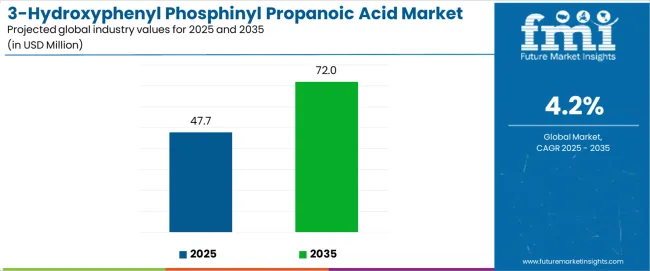
| Period | Primary Revenue Buckets | Share | Notes |
|---|---|---|---|
| Today | 98% Purity pharmaceutical intermediates | 62% | Standard pharmaceutical applications, established manufacturers |
| 99% Purity high-grade materials | 31% | Premium applications, specialized synthesis | |
| Others (custom purities) | 7% | Research applications, custom specifications | |
| Future (3-5 yrs) | Advanced 98% purity systems | 52-55% | Enhanced synthesis processes, optimized production |
| Ultra-high purity 99%+ materials | 28-32% | Precision pharmaceuticals, advanced drug development | |
| Pharmaceutical intermediate applications | 15-18% | Drug discovery, API synthesis, biotech applications | |
| Chemical raw material uses | 8-12% | Industrial chemistry, specialty synthesis | |
| Research & development applications | 5-8% | Academic research, novel drug development | |
| Custom synthesis solutions | 3-6% | Bespoke purities, specialized applications |
At-a-Glance Metrics
| Metric | Value |
|---|---|
| Market Value (2025) | USD 47.69 million |
| Market Forecast (2035) | USD 71.97 million |
| Growth Rate | 4.2% CAGR |
| Leading Purity Grade | 98% Purity |
| Primary Application | Pharmaceutical Intermediates |
The 3-hydroxyphenyl phosphinyl propanoic acid market demonstrates strong fundamentals with 98% purity grade systems capturing a dominant share through advanced synthesis properties and pharmaceutical application optimization. Pharmaceutical intermediate applications drive primary demand, supported by increasing drug development requirements and pharmaceutical industry modernization initiatives. Geographic expansion remains concentrated in developed markets with established pharmaceutical infrastructure, while emerging economies show accelerating adoption rates driven by pharmaceutical industry modernization initiatives and rising quality standards.
Primary Classification: The 3-hydroxyphenyl phosphinyl propanoic acid market segments by purity grade into 98% purity, 99% purity, and others, representing the evolution from standard pharmaceutical intermediates to ultra-high purity materials for comprehensive drug development optimization.
Secondary Classification: Application segmentation divides the 3-hydroxyphenyl phosphinyl propanoic acid market into pharmaceutical intermediates, chemical raw materials, and others, reflecting distinct requirements for compound quality, synthesis specifications, and regulatory compliance standards.
Tertiary Classification: End-use segmentation covers pharmaceutical companies, biotechnology firms, contract research organizations, academic institutions, and specialty chemical manufacturers, while distribution channels span direct sales, chemical distributors, and specialized pharmaceutical suppliers.
Regional Classification: Geographic distribution covers North America, Latin America, Western Europe, Eastern Europe, East Asia, South Asia Pacific, and Middle East & Africa, with developed markets leading adoption while emerging economies show accelerating growth patterns driven by pharmaceutical industry modernization programs.
The segmentation structure reveals purity progression from standard 98% pharmaceutical intermediates toward ultra-high purity materials with enhanced synthesis capabilities, while application diversity spans from drug discovery to industrial chemistry requiring precision compound solutions.
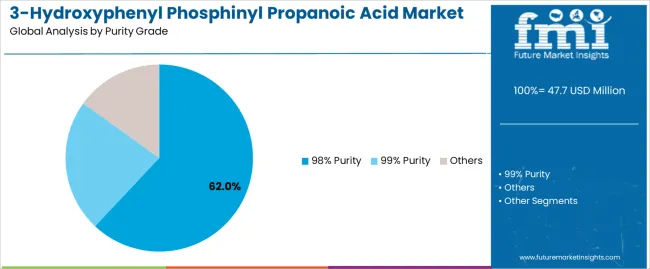
Market Position: 98% purity grade systems command the leading position in the 3-hydroxyphenyl phosphinyl propanoic acid market with 62% market share through proven synthesis technologies, including optimized reaction conditions, consistent quality properties, and pharmaceutical compliance optimization that enable pharmaceutical manufacturers to achieve optimal drug development outcomes across diverse research and production environments.
Value Drivers: The segment benefits from pharmaceutical industry preference for reliable intermediate systems that provide consistent quality, regulatory compliance, and synthesis efficiency without requiring ultra-high purity infrastructure. Advanced synthesis processing features enable enhanced yield optimization, cost-effective production, and integration with existing pharmaceutical programs, where quality performance and regulatory compliance represent critical operational requirements.
Competitive Advantages: 98% purity systems differentiate through proven synthesis reliability, consistent quality characteristics, and integration with established pharmaceutical manufacturing systems that enhance facility effectiveness while maintaining optimal regulatory standards suitable for diverse pharmaceutical applications.
Key market characteristics:
99% purity systems maintain a 31% market position in the 3-hydroxyphenyl phosphinyl propanoic acid market due to their performance advantages and ultra-high quality positioning benefits. These materials appeal to facilities requiring premium compound solutions with enhanced purity profiles for specialized pharmaceutical operations. Market growth is driven by advanced drug development expansion, emphasizing high-purity compound solutions and operational precision through optimized synthesis designs.
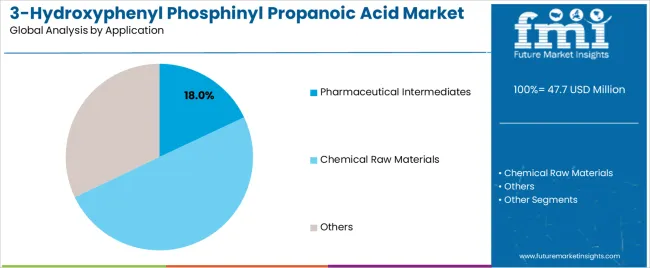
Market Context: Pharmaceutical intermediate applications demonstrate strong growth in the 3-hydroxyphenyl phosphinyl propanoic acid market with 5.8% CAGR and 18% market share due to widespread adoption of advanced drug development programs and increasing focus on pharmaceutical innovation, regulatory compliance efficiency, and synthesis optimization applications that maximize compound effectiveness while maintaining quality standards.
Appeal Factors: Pharmaceutical companies prioritize compound reliability, synthesis consistency, and integration with existing drug development infrastructure that enables coordinated intermediate operations across multiple research departments. The segment benefits from substantial pharmaceutical industry investment and modernization programs that emphasize the acquisition of premium intermediates for drug differentiation and development efficiency applications.
Growth Drivers: Drug development programs incorporate 3-hydroxyphenyl phosphinyl propanoic acid as essential components for pharmaceutical synthesis, while biotech expansion increases demand for intermediate capabilities that comply with regulatory standards and minimize development complexity.
Market Challenges: Varying regulatory requirements and synthesis complexity may limit intermediate standardization across different pharmaceutical companies or research scenarios.
Application dynamics include:
Chemical raw materials applications capture 35% market share through specialized synthesis requirements in industrial chemistry, specialty manufacturing, and chemical applications. These facilities demand reliable compounds capable of supporting synthesis requirements while providing chemical compatibility access and operational efficiency capabilities.
Others applications account for 18% market share, including research institutions, academic facilities, and custom synthesis operations requiring specialized compound capabilities for innovation optimization and research effectiveness.
Market Context: Pharmaceutical Companies dominate the 3-hydroxyphenyl phosphinyl propanoic acid market with 5.1% CAGR, reflecting the primary demand source for 3-hydroxyphenyl phosphinyl propanoic acid technology in drug development applications and synthesis standardization.
Business Model Advantages: Pharmaceutical Companies provide direct market demand for high-quality intermediate systems, driving volume production and cost optimization while maintaining quality control and regulatory compliance requirements.
Operational Benefits: Pharmaceutical Company applications include synthesis standardization, cost efficiency, and quality assurance that drive consistent demand for intermediate systems while providing access to latest compound technologies.
| Category | Factor | Impact | Why It Matters |
|---|---|---|---|
| Driver | Pharmaceutical industry growth & drug development expansion (R&D investment, biotech growth) | ★★★★★ | Growing pharmaceutical market requires specialized intermediates with enhanced synthesis capabilities and purity properties proven effective across drug development applications. |
| Driver | Regulatory compliance advancement & quality requirements (API standards, pharmaceutical regulations) | ★★★★★ | Transforms intermediate requirements from "basic chemicals" to "pharmaceutical-grade materials"; companies that offer quality compounds and compliance features gain competitive advantage. |
| Driver | Biotechnology market growth & advanced drug development (precision medicine, novel therapeutics) | ★★★★☆ | Biotech companies need high-purity, reliable intermediates; demand for exclusive and superior compound solutions expanding addressable market. |
| Restraint | Cost pressures & budget constraints (especially for smaller pharmaceutical companies) | ★★★★☆ | Smaller pharmaceutical operators defer premium intermediate purchases; increases price sensitivity and slows high-purity compound adoption in cost-conscious markets. |
| Restraint | Alternative synthesis routes competition (generic intermediates, substitute compounds) | ★★★☆☆ | Alternative synthesis pathways offer established supply chains and lower costs, potentially limiting 3-hydroxyphenyl phosphinyl propanoic acid adoption in traditional applications. |
| Trend | Synthesis technology integration & purity enhancement (advanced synthesis, quality analytics) | ★★★★★ | Advanced synthesis properties, purity optimization, and analytical monitoring transform operations; technology integration and quality enhancement become core value propositions. |
| Trend | Customization & application-specific solutions (custom synthesis, specialized purities) | ★★★★☆ | Custom compounds for specific applications and pharmaceutical needs; specialized synthesis and targeted purity capabilities drive competition toward customization solutions. |
The 3-hydroxyphenyl phosphinyl propanoic acid market demonstrates varied regional dynamics with Growth Leaders including China (5.67% growth rate) and India (5.25% growth rate) driving expansion through pharmaceutical development initiatives and chemical industry modernization. Steady Performers encompass Germany (4.83% growth rate), Brazil (4.41% growth rate), and developed regions, benefiting from established pharmaceutical industries and high-purity compound adoption. Mature Markets feature United States (3.99% growth rate), United Kingdom (3.57% growth rate), and Japan (3.15% growth rate), where pharmaceutical advancement and synthesis standardization requirements support consistent growth patterns.
Regional synthesis reveals East Asian markets leading adoption through pharmaceutical expansion and chemical industry development, while North American countries maintain steady expansion supported by compound technology advancement and regulatory compliance requirements. European markets show strong growth driven by pharmaceutical applications and quality integration trends.
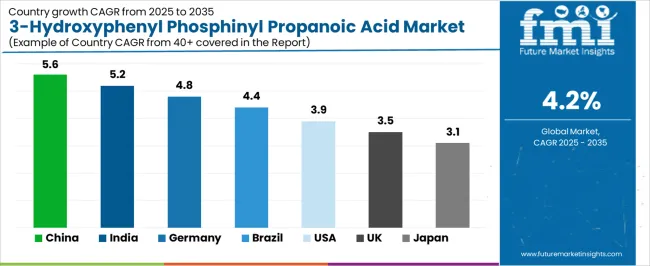
| Region/Country | 2025-2035 Growth | How to win | What to watch out |
|---|---|---|---|
| China | 5.6 | Focus on volume production solutions | Regulatory changes; local competition |
| India | 5.2 | Lead with cost-effective manufacturing | Import restrictions; quality barriers |
| Germany | 4.8 | Provide premium quality compounds | Over-regulation; lengthy approvals |
| Brazil | 4.4 | Offer value-oriented solutions | Currency fluctuations; import duties |
| United States | 3.9 | Push technology integration | Compliance costs; scaling challenges |
| United Kingdom | 3.5 | Focus on pharmaceutical applications | Economic impacts; compound costs |
| Japan | 3.1 | Emphasize quality manufacturing | Traditional preferences; adoption rates |
China establishes fastest market growth through aggressive pharmaceutical development programs and comprehensive chemical industry expansion, integrating advanced 3-hydroxyphenyl phosphinyl propanoic acid systems as standard components in pharmaceutical facilities and chemical manufacturing installations. The country's 5.6% growth rate reflects government initiatives promoting pharmaceutical infrastructure and domestic chemical capabilities that mandate the use of high-purity intermediate systems in pharmaceutical and chemical facilities. Growth concentrates in major pharmaceutical hubs, including Beijing, Shanghai, and Guangzhou, where pharmaceutical development showcases integrated compound systems that appeal to pharmaceutical operators seeking synthesis optimization capabilities and production applications.
Chinese manufacturers are developing cost-effective compound solutions that combine domestic production advantages with advanced purity features, including enhanced synthesis control and improved quality capabilities. Distribution channels through pharmaceutical suppliers and chemical distributors expand market access, while government support for pharmaceutical development supports adoption across diverse pharmaceutical and chemical segments.
Strategic Market Indicators:
In Mumbai, Delhi, and Bangalore, pharmaceutical facilities and chemical operators are implementing high-purity 3-hydroxyphenyl phosphinyl propanoic acid systems as standard materials for drug development and synthesis optimization applications, driven by increasing government pharmaceutical investment and chemical modernization programs that emphasize the importance of quality intermediate capabilities. The 3-hydroxyphenyl phosphinyl propanoic acid market holds a 5.2% growth rate, supported by government pharmaceutical initiatives and chemical development programs that promote high-purity intermediate systems for pharmaceutical and chemical facilities. Indian operators are adopting compound systems that provide consistent synthesis performance and purity features, particularly appealing in urban regions where pharmaceutical development and operational excellence represent critical business requirements.
Market expansion benefits from growing pharmaceutical capabilities and international research partnerships that enable domestic production of high-purity intermediate systems for pharmaceutical and chemical applications. Technology adoption follows patterns established in pharmaceutical equipment, where reliability and purity drive procurement decisions and operational deployment.
Market Intelligence Brief:
Germany's advanced pharmaceutical market demonstrates sophisticated 3-hydroxyphenyl phosphinyl propanoic acid deployment with documented synthesis effectiveness in pharmaceutical applications and chemical facilities through integration with existing pharmaceutical systems and operational infrastructure. The country leverages engineering expertise in chemicals and quality systems integration to maintain a 4.8% growth rate. Pharmaceutical centers, including Bavaria, Baden-Württemberg, and North Rhine-Westphalia, showcase premium installations where compound systems integrate with comprehensive pharmaceutical platforms and facility management systems to optimize synthesis performance and operational effectiveness.
German manufacturers prioritize system quality and EU compliance in compound development, creating demand for premium systems with advanced features, including facility integration and pharmaceutical compliance systems. The 3-hydroxyphenyl phosphinyl propanoic acid market benefits from established pharmaceutical infrastructure and a willingness to invest in high-purity compound technologies that provide long-term operational benefits and compliance with international pharmaceutical standards.
Market Intelligence Brief:
Brazil's market expansion benefits from diverse pharmaceutical demand, including pharmaceutical modernization in São Paulo and Rio de Janeiro, chemical facility upgrades, and government pharmaceutical programs that increasingly incorporate high-purity intermediate solutions for synthesis applications. The country maintains a 4.4% growth rate, driven by rising pharmaceutical activity and increasing recognition of high-purity intermediate benefits, including precise synthesis control and enhanced operational effectiveness.
Market dynamics focus on cost-effective compound solutions that balance synthesis performance with affordability considerations important to Brazilian pharmaceutical operators. Growing pharmaceutical industrialization creates continued demand for modern intermediate systems in new pharmaceutical infrastructure and facility modernization projects.
Strategic Market Considerations:
United States establishes market leadership through comprehensive pharmaceutical programs and advanced chemical infrastructure development, integrating 3-hydroxyphenyl phosphinyl propanoic acid systems across pharmaceutical and chemical applications. The country's 3.9% growth rate reflects established pharmaceutical industry relationships and mature compound technology adoption that supports widespread use of high-purity intermediate systems in pharmaceutical and chemical facilities. Growth concentrates in major pharmaceutical centers, including California, New Jersey, and Massachusetts, where compound technology showcases mature deployment that appeals to pharmaceutical operators seeking proven synthesis capabilities and operational efficiency applications.
American pharmaceutical providers leverage established distribution networks and comprehensive technical support capabilities, including analytical programs and regulatory support that create customer relationships and operational advantages. The 3-hydroxyphenyl phosphinyl propanoic acid market benefits from mature regulatory standards and pharmaceutical requirements that mandate intermediate system use while supporting technology advancement and operational optimization.
Market Intelligence Brief:
United Kingdom's pharmaceutical market demonstrates integrated 3-hydroxyphenyl phosphinyl propanoic acid deployment with documented synthesis effectiveness in pharmaceutical applications and chemical facilities through integration with existing pharmaceutical systems and operational infrastructure. The country maintains a 3.5% growth rate, supported by pharmaceutical excellence programs and synthesis effectiveness requirements that promote high-purity intermediate systems for pharmaceutical applications. Pharmaceutical facilities across England, Scotland, and Wales showcase systematic installations where compound systems integrate with comprehensive pharmaceutical platforms to optimize synthesis performance and operational outcomes.
UK pharmaceutical providers prioritize system reliability and industry compatibility in compound procurement, creating demand for validated systems with proven synthesis features, including quality monitoring integration and pharmaceutical compliance systems. The 3-hydroxyphenyl phosphinyl propanoic acid market benefits from established pharmaceutical infrastructure and excellence requirements that support compound technology adoption and operational effectiveness.
Market Intelligence Brief:
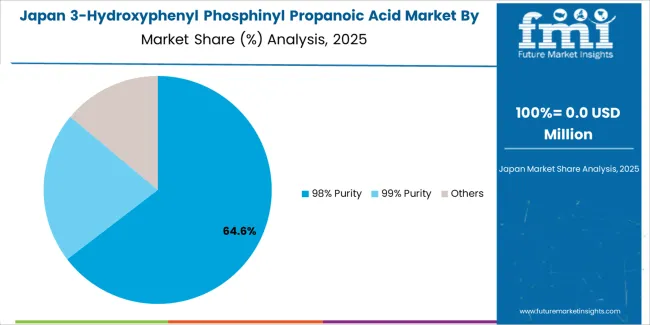
Japan's market growth benefits from precision pharmaceutical demand, including advanced pharmaceutical facilities in Tokyo and Osaka, quality integration, and research enhancement programs that increasingly incorporate intermediate solutions for synthesis applications. The country maintains a 3.1% growth rate, driven by pharmaceutical technology advancement and increasing recognition of precision intermediate benefits, including accurate synthesis control and enhanced research outcomes.
Market dynamics focus on high-precision compound solutions that meet Japanese quality standards and synthesis effectiveness requirements important to pharmaceutical operators. Advanced pharmaceutical technology adoption creates continued demand for sophisticated intermediate systems in pharmaceutical facility infrastructure and research modernization projects.
Strategic Market Considerations:
The European 3-hydroxyphenyl phosphinyl propanoic acid market is projected to grow from USD 10.8 million in 2025 to USD 16.4 million by 2035, registering a CAGR of 4.3% over the forecast period. Germany is expected to maintain its leadership position with a 42.1% market share in 2025, supported by its advanced pharmaceutical infrastructure and major chemical manufacturing centers.
United Kingdom follows with a 28.3% share in 2025, driven by comprehensive pharmaceutical programs and chemical excellence development initiatives. France holds a 16.7% share through specialized pharmaceutical applications and regulatory compliance requirements. Italy commands a 8.9% share, while Spain accounts for 4.0% in 2025. The rest of Europe region is anticipated to gain momentum, expanding its collective share from 2.8% to 3.1% by 2035, attributed to increasing pharmaceutical adoption in Nordic countries and emerging chemical facilities implementing pharmaceutical modernization programs.
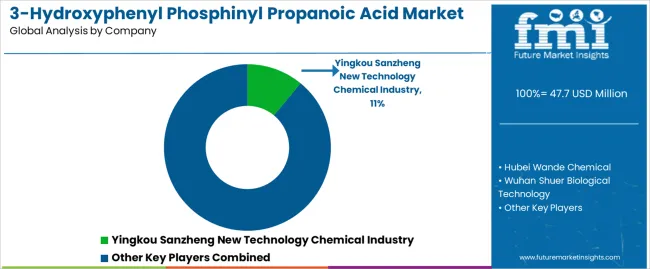
| Stakeholder | What they actually control | Typical strengths | Typical blind spots |
|---|---|---|---|
| Global manufacturers | Production capacity, broad compound portfolios, regulatory compliance | Wide availability, proven quality, multi-region support | Product innovation cycles; customer dependency on regulatory validation |
| Technology innovators | Synthesis R&D; advanced purity technologies; enhanced quality properties | Latest technologies first; attractive ROI on synthesis effectiveness | Service density outside core regions; scaling complexity |
| Regional specialists | Local compliance, fast delivery, nearby customer support | "Close to customer" support; pragmatic pricing; local regulations | Technology gaps; talent retention in technical service |
| Full-service providers | Synthesis programs, analytical services, regulatory support | Lowest operational risk; comprehensive support | Service costs if overpromised; technology obsolescence |
| Niche specialists | Specialized applications, custom synthesis, analytical services | Win premium applications; flexible configurations | Scalability limitations; narrow market focus |
| Item | Value |
|---|---|
| Quantitative Units | USD 47.69 million |
| Purity Grade | 98% Purity, 99% Purity, Others |
| Application | Pharmaceutical Intermediates, Chemical Raw Materials, Others |
| End Use | Pharmaceutical Companies, Biotechnology Firms, Contract Research Organizations, Academic Institutions, Specialty Chemical Manufacturers |
| Regions Covered | North America, Latin America, Western Europe, Eastern Europe, East Asia, South Asia Pacific, Middle East & Africa |
| Countries Covered | China, India, Germany, Brazil, United States, United Kingdom, Japan, Canada, France, Australia, and 25+ additional countries |
| Key Companies Profiled | Yingkou Sanzheng New Technology Chemical Industry, Hubei Wande Chemical, Wuhan Shuer Biological Technology, Unilong Industry, Yinglang Chemical, Shandong Dongke Chemical Technology |
| Additional Attributes | Dollar sales by purity grade and application categories, regional adoption trends across East Asia, North America, and Western Europe, competitive landscape with chemical manufacturers and pharmaceutical suppliers, pharmaceutical operator preferences for compound effectiveness and synthesis optimization, integration with pharmaceutical platforms and quality management systems, innovations in synthesis technology and compound enhancement, and development of advanced intermediate solutions with enhanced purity and operational optimization capabilities. |
The global 3-hydroxyphenyl phosphinyl propanoic acid market is estimated to be valued at USD 47.7 million in 2025.
The market size for the 3-hydroxyphenyl phosphinyl propanoic acid market is projected to reach USD 72.0 million by 2035.
The 3-hydroxyphenyl phosphinyl propanoic acid market is expected to grow at a 4.2% CAGR between 2025 and 2035.
The key product types in 3-hydroxyphenyl phosphinyl propanoic acid market are 98% purity, 99% purity and others.
In terms of application, pharmaceutical intermediates segment to command 18.0% share in the 3-hydroxyphenyl phosphinyl propanoic acid market in 2025.






Full Research Suite comprises of:
Market outlook & trends analysis
Interviews & case studies
Strategic recommendations
Vendor profiles & capabilities analysis
5-year forecasts
8 regions and 60+ country-level data splits
Market segment data splits
12 months of continuous data updates
DELIVERED AS:
PDF EXCEL ONLINE
Acid Coil Cleaner Market Size and Share Forecast Outlook 2025 to 2035
Acid Filling and Leveling Machine Market Size and Share Forecast Outlook 2025 to 2035
Acid Chlorides Market Size and Share Forecast Outlook 2025 to 2035
Acid-Sensitive APIs Market Analysis - Size, Share, and Forecast Outlook 2025 to 2035
Acidified Whey Protein Market Analysis - Size, Share & Trends 2025 to 2035
Acid Dyes Market Growth - Trends & Forecast 2025 to 2035
Acidity Regulator Market Growth - Trends & Forecast 2025 to 2035
Acid Proof Lining Market Trends 2025 to 2035
Acid Citrate Dextrose Tube Market Trends – Growth & Industry Outlook 2024-2034
Acid Orange Market
Antacids Market Analysis – Size, Trends & Forecast 2025 to 2035
Lead Acid Battery Market Size and Share Forecast Outlook 2025 to 2035
Lead Acid Battery Recycling Market Size and Share Forecast Outlook 2025 to 2035
Feed Acidifier Market Analysis Size Share and Forecast Outlook 2025 to 2035
Food Acidulants Market Growth - Key Trends, Size & Forecast 2024 to 2034
Folic Acid Market Size and Share Forecast Outlook 2025 to 2035
Oleic Acid Market Size and Share Forecast Outlook 2025 to 2035
Dimer Acid-based (DABa) Polyamide Resin Market Size and Share Forecast Outlook 2025 to 2035
Humic Acid Market Size and Share Forecast Outlook 2025 to 2035
Fatty Acids Market Size and Share Forecast Outlook 2025 to 2035

Thank you!
You will receive an email from our Business Development Manager. Please be sure to check your SPAM/JUNK folder too.
Chat With
MaRIA